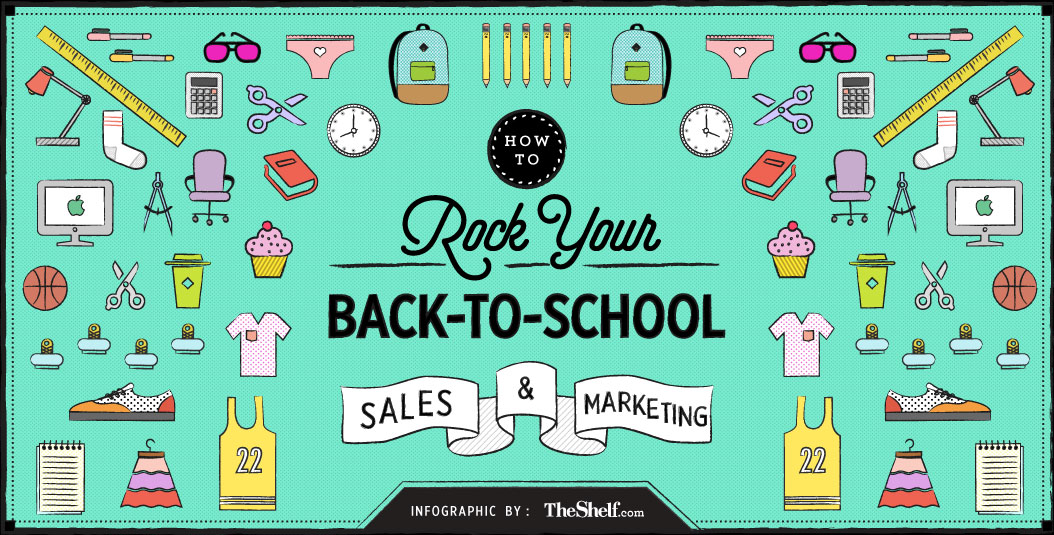
Good news: the second biggest retail holidays are there.
Okay, it is good, but it is not news. However, maybe you didn’t know about the $828 billion estimation for its 2016 customer expenses?
I guess I taught you something.
Anyways, Back-to-School 2016 is here. And actually, it has been for the past four months. $828 billion is quite a piece (actually about 17.2% of a year’s retail sales) and you might want to get some of it. And if, like some kind of creative parents out there, you are late, have a look at TheShelf’s infographic below. You sure will learn more about how to get profit from it.
Timing
Timing makes Back-to-School marketing a little challenging.
Indeed, there are no clear deadlines as to when this period starts or ends. Studies show that people shop from April to September, with peak times for different product types.
So, should you start launching your marketing by the end of March, or should you wait for the last minute stress in July? It depends on your product, and the effect you want to make on your customer. Do you want to sound like the well-prepared type of brand, or more like the rescue one? Maybe you can try both: a first campaign for the foresighted individuals, and another for the procrastinators and the busy ones.
Also, depending on your business’ location, students may start school as early as the 20th of July (Chandler, AZ), or as late as the 9th of September (New York City, N.Y. and Seattle, WA). If you decide to launch a late campaign in California, do not wait until the end of August. (You would be outdated, they are already in school.)
Products Sold, and Products Bought
If you are looking up this article, it may be that your business is somehow linked to schools, or the schooling environment – in someway.
Actually, the three types of products sold during this period are clothing, supplies, and snacks. Whilst it seems obvious that snacks will be bought towards the end of the holiday, clothing happen to be bought more or less all the time, and supplies really at the beginning of the school holiday.
Parents and schoolers buy according to three factors:
- what is useful
- their kid’s/own taste
- discounts
If the final choice remains in parents’ hands (for underaged kids), they are greatly influenced (59% admit it) by their children. Usefulness is a must, and brands are a detail. What really matters to kids is the appearance. Can they brag about it? If you are selling material for advanced high-schoolers or college students, then make sure the product is plain, and well-suited, practical. At some age, it is not about how cute a pair of scissors looks anymore, it is about the efficient ‘can it cut well, and fit in my pencil-case’ feature.
Discounts are the last factor entering customers’ mental algorithm. Sure, back-to-school holiday is a great opportunity (again, worth $828 billion this year) to make money. Just like Christmas, everyone knows they will have to buy. Therefore, the demand is inelastic. So why not increase your prices? Because you can’t. The competition is harsh, and if you want to be part of it, you have to make discounts, and bring your prices down. Customers will notice it, and be keener to buy your products rather than your neighbor’s. True story.
Do Not Neglect the Digital World
We are living in weird times where people are as physically present than they are virtually. Indeed, you may witness rush in supermarkets, with parents and kids going from one end of the shop to another; yet, this doesn’t mean they are not also doing it at home. Online purchases represent 7.9% of the overall sales. It is not to be neglected.
Also, not only do parents, or students buy online, but they also check for discounts, and seek for online advice. The better feedback you have on your products, the more customers will be willing to buy it. Logical and straightforward? Sure, but I bet you forget your company’s image too many times in your marketing strategy.
Many other tips are given throughout the infographic. I’ll let you check it out. Read through all these detailed data, and make some of your own business decisions according to it. For now, as a college student, I’ve got some back-to-school shopping to do. 😉


![[Infographic] Rock Your Back-to-School Sales and Marketing](https://www.doz.com/wp-content/uploads/2016/08/back-to-school-infographic-the-shelf-social-image2-951x483.jpg)

6 Comments
Sutter Health
Nice post. I learn something new and challenging on blogs I stumbleupon on a daily basis.
Great post Thank you. I look forward to the continuation.
I appreciate you sharing this blog post. Thanks Again. Cool.
Good post! We will be linking to this particularly great post on our site. Keep up the great writing
We always follow your beautiful content I look forward to the continuation.Olaismln Premium Garage Floor mats for Under car Oil Spill Mat Waterproof Backing Reusable Washable Durable Protective Garage Floor Surface 36 X 59 Inches – Hot Deals